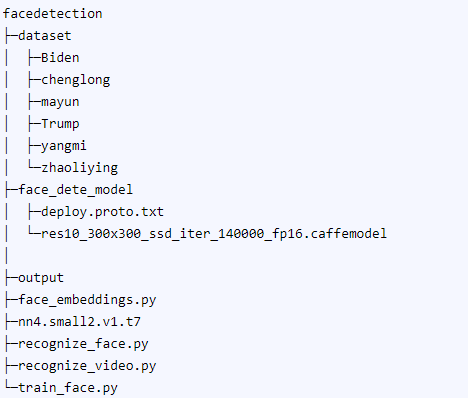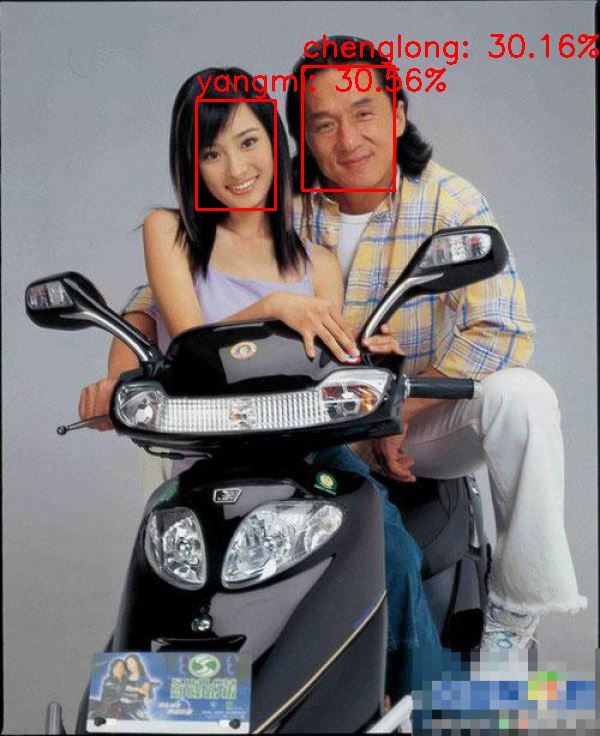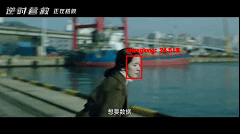您好,登錄后才能下訂單哦!
您好,登錄后才能下訂單哦!
Opencv+SVM怎樣實現人臉識別,針對這個問題,這篇文章詳細介紹了相對應的分析和解答,希望可以幫助更多想解決這個問題的小伙伴找到更簡單易行的方法。
如何使用 OpenCV 進行人臉識別。
第一,將首先執行人臉檢測,使用深度學習從每個人臉中提取人臉量化為128位的向量。
第二, 在嵌入基礎上使用支持向量機(SVM)訓練人臉識別模型。
第三,最后使用 OpenCV 識別圖像和視頻流中的人臉。

新建face_embeddings.py腳本,寫入如下代碼:
# import the necessary packages import numpy as np import pickle import cv2 import os import os
導入需要的包。然后定義幾個函數:
def list_images(basePath, contains=None):
# return the set of files that are valid
return list_files(basePath, validExts=image_types, contains=contains)
def list_files(basePath, validExts=None, contains=None):
# loop over the directory structure
for (rootDir, dirNames, filenames) in os.walk(basePath):
# loop over the filenames in the current directory
for filename in filenames:
# if the contains string is not none and the filename does not contain
# the supplied string, then ignore the file
if contains is not None and filename.find(contains) == -1:
continue
# determine the file extension of the current file
ext = filename[filename.rfind("."):].lower()
# check to see if the file is an image and should be processed
if validExts is None or ext.endswith(validExts):
# construct the path to the image and yield it
imagePath = os.path.join(rootDir, filename)
yield imagePath
def resize(image, width=None, height=None, inter=cv2.INTER_AREA):
dim = None
(h, w) = image.shape[:2]
# 如果高和寬為None則直接返回
if width is None and height is None:
return image
# 檢查寬是否是None
if width is None:
# 計算高度的比例并并按照比例計算寬度
r = height / float(h)
dim = (int(w * r), height)
# 高為None
else:
# 計算寬度比例,并計算高度
r = width / float(w)
dim = (width, int(h * r))
resized = cv2.resize(image, dim, interpolation=inter)
# return the resized image
return resizedlist_images函數,讀取數據集文件夾下面的圖片。
resize函數,等比例resize圖片。接下來定義一些變量:
dataset_path='dataset' embeddings_path='output/embeddings.pickle' detector_path='face_dete_model' embedding_model='nn4.small2.v1.t7' confidence_low=0.5
dataset_path:數據集路徑
embeddings_path:輸出編碼文件的路徑
detector_path:人臉檢測模型的路徑
embedding_model:編碼模型
confidence_low:最低的置信度。
接下來就是代碼的最重要的部分:
print("loading face detector...")
protoPath = os.path.sep.join([detector_path, "deploy.proto.txt"])
modelPath = os.path.sep.join([detector_path,"res10_300x300_ssd_iter_140000_fp16.caffemodel"])
detector = cv2.dnn.readNetFromCaffe(protoPath, modelPath)
# 加載序列化的人臉編碼模型
print("loading face recognizer...")
embedder = cv2.dnn.readNetFromTorch(embedding_model)
# 獲取數據集中輸入圖像的路徑
print("quantifying faces...")
imagePaths = list(list_images(dataset_path))
# 初始化我們提取的面部編碼列表和相應的人名
knownEmbeddings = []
knownNames = []
# 初始化處理的人臉總數
total = 0
# loop over the image paths
for (i, imagePath) in enumerate(imagePaths):
# extract the person name from the image path
print("processing image {}/{}".format(i + 1,len(imagePaths)))
name = imagePath.split(os.path.sep)[-2]
# 加載圖像,將其調整為寬度為 600 像素(同時保持縱橫比),然后抓取圖像尺寸
image = cv2.imread(imagePath)
image = resize(image, width=600)
(h, w) = image.shape[:2]
# 從圖像構建一個 blob
imageBlob = cv2.dnn.blobFromImage(
cv2.resize(image, (300, 300)), 1.0, (300, 300),
(104.0, 177.0, 123.0), swapRB=False, crop=False)
# 使用 OpenCV 的基于深度學習的人臉檢測器來定位輸入圖像中的人臉
detector.setInput(imageBlob)
detections = detector.forward()
# ensure at least one face was found
if len(detections) > 0:
# 假設每個圖像只有一張臉,所以找到概率最大的邊界框
i = np.argmax(detections[0, 0, :, 2])
confidence = detections[0, 0, i, 2]
# 確保最大概率的檢測也意味著我們的最小概率測試(從而幫助過濾掉弱檢測)
if confidence > confidence_low:
# 計算人臉邊界框的 (x, y) 坐標
box = detections[0, 0, i, 3:7] * np.array([w, h, w, h])
(startX, startY, endX, endY) = box.astype("int")
# 提取人臉ROI并抓取ROI維度
face = image[startY:endY, startX:endX]
(fH, fW) = face.shape[:2]
# 確保人臉寬度和高度足夠大
if fW < 20 or fH < 20:
continue
# 為人臉 ROI 構造一個 blob,然后將 blob 通過我們的人臉嵌入模型來獲得人臉的 128-d 量化
faceBlob = cv2.dnn.blobFromImage(face, 1.0 / 255,
(96, 96), (0, 0, 0), swapRB=True, crop=False)
embedder.setInput(faceBlob)
vec = embedder.forward()
# 將人名+對應的人臉嵌入添加到各自的列表中
knownNames.append(name)
knownEmbeddings.append(vec.flatten())
total += 1
# 保存編碼文件
print("serializing {} encodings...".format(total))
data = {"embeddings": knownEmbeddings, "names": knownNames}
f = open(embeddings_path, "wb")
f.write(pickle.dumps(data))
f.close()加載人臉檢測器和編碼器:
檢測器:使用基于Caffe的DL人臉檢測器來定位圖像中的人臉。
編碼器:模型基于Torch,負責通過深度學習特征提取來提取人臉編碼。
接下來,讓我們抓取圖像路徑并執行初始化。
遍歷 imagePaths。從路徑中提取人名。
構造了一個 blob。
然后,通過將 imageBlob 通過檢測器網絡來檢測圖像中的人臉。
檢測列表包含定位圖像中人臉的概率和坐標。
假設我們至少有一個檢測,將進入 if 語句的主體。
假設圖像中只有一張臉,因此提取具有最高置信度的檢測并檢查以確保置信度滿足用于過濾弱檢測的最小概率閾值。
假設已經達到了這個閾值,提取面部 ROI 并抓取/檢查尺寸以確保面部 ROI 足夠大。
然后,我們將利用編碼器 并提取人臉編碼。
繼續構建另一個 blob。
隨后,將 faceBlob 通過編碼器 。 這會生成一個 128 維向量 (vec) 來描述面部。
然后我們簡單地將名稱和嵌入 vec 分別添加到 knownNames 和 knownEmbeddings 中。
繼續循環圖像、檢測人臉并為數據集中的每個圖像提取人臉編碼的過程。
循環結束后剩下的就是將數據轉儲到磁盤。
運行結果:
loading face detector...
loading face recognizer...
quantifying faces...
processing image 1/19
processing image 2/19
processing image 3/19
processing image 4/19
processing image 5/19
processing image 6/19
processing image 7/19
processing image 8/19
processing image 9/19
processing image 10/19
processing image 11/19
processing image 12/19
processing image 13/19
processing image 14/19
processing image 15/19
processing image 16/19
processing image 17/19
processing image 18/19
processing image 19/19
serializing 19 encodings...
Process finished with exit code 0
已經為每張臉提取了 128 維編碼——但是我們如何根據這些嵌入來識別一個人呢?
答案是我們需要在嵌入之上訓練一個“標準”機器學習模型(例如 SVM、k-NN 分類器、隨機森林等)。
今天我們使用SVM實現
打開 train_face.py 文件并插入以下代碼:
from sklearn.preprocessing import LabelEncoder
from sklearn.svm import SVC
import pickle
embeddings_path='output/embeddings.pickle'
recognizer_path='output/recognizer.pickle'
lable_path='output/le.pickle'
# 加載編碼模型
print("[INFO] loading face embeddings...")
data = pickle.loads(open(embeddings_path, "rb").read())
# 給label編碼
print("[INFO] encoding labels...")
le = LabelEncoder()
labels = le.fit_transform(data["names"])
# 訓練用于接受人臉 128-d 嵌入的模型,然后產生實際的人臉識別
recognizer = SVC(C=1.0, kernel="linear", probability=True)
recognizer.fit(data["embeddings"], labels)
# 保存模型
f = open(recognizer_path, "wb")
f.write(pickle.dumps(recognizer))
f.close()
# 保存lable
f = open(lable_path, "wb")
f.write(pickle.dumps(le))
f.close()導入包和模塊。 我們將使用 scikit-learn 的支持向量機 (SVM) 實現,這是一種常見的機器學習模型。
定義變量。
embeddings_path:序列化編碼。
recognizer_path:這將是我們識別人臉的輸出模型。 它基于 SVM。
lable_path:標簽編碼器輸出文件路徑
加載編碼。
然后初始化 scikit-learn LabelEncoder 并編碼名稱標簽。
訓練模型。本文使用的是線性支持向量機 (SVM),但如果您愿意,您可以嘗試使用其他機器學習模型進行試驗。
訓練模型后,我們將模型和標簽編碼器保存到電腦上。
運行train_face.py 腳本。
新建腳本文件recognize_face.py,插入一下代碼:
import numpy as np import pickle import cv2 import os
導入包,然后我們需要新增一個resize方法。
def resize(image, width=None, height=None, inter=cv2.INTER_AREA): dim = None (h, w) = image.shape[:2] # 如果高和寬為None則直接返回 if width is None and height is None: return image # 檢查寬是否是None if width is None: # 計算高度的比例并并按照比例計算寬度 r = height / float(h) dim = (int(w * r), height) # 高為None else: # 計算寬度比例,并計算高度 r = width / float(w) dim = (width, int(h * r)) resized = cv2.resize(image, dim, interpolation=inter) # return the resized image return resized
等比例resize圖像,定義變量:
image_path = '11.jpg' detector_path = 'face_dete_model' embedding_path = 'nn4.small2.v1.t7' recognizer_path = 'output/recognizer.pickle' label_path = 'output/le.pickle' confidence_low = 0.5
這六個變量的含義如下:
image_path :輸入圖像的路徑。
detector_path:OpenCV 深度學習人臉檢測器的路徑。 使用這個模型來檢測人臉 ROI 在圖像中的位置。
embedding_path : OpenCV 深度學習人臉編碼模型的路徑。 我們將使用這個模型從人臉 ROI 中提取 128 維人臉嵌入——然后將把數據輸入到識別器中。
recognizer_path :識別器模型的路徑。
label_path : 標簽編碼器的路徑。
confidence_low:過濾弱人臉檢測的可選閾值。
接下來是代碼的主體部分:
# 加載序列化人臉檢測器
print("[INFO] loading face detector...")
protoPath = os.path.sep.join([detector_path, "deploy.proto.txt"])
modelPath = os.path.sep.join([detector_path,"res10_300x300_ssd_iter_140000_fp16.caffemodel"])
detector = cv2.dnn.readNetFromCaffe(protoPath, modelPath)
# 加載我們序列化的人臉編碼模型
print("[INFO] loading face recognizer...")
embedder = cv2.dnn.readNetFromTorch(embedding_path)
# 加載實際的人臉識別模型和標簽編碼器
recognizer = pickle.loads(open(recognizer_path, "rb").read())
le = pickle.loads(open(label_path, "rb").read())
# 加載圖像,將其調整為寬度為 600 像素(同時保持縱橫比),然后抓取圖像尺寸
image = cv2.imread(image_path)
image = resize(image, width=600)
(h, w) = image.shape[:2]
# 從圖像構建一個 blob
imageBlob = cv2.dnn.blobFromImage(
cv2.resize(image, (300, 300)), 1.0, (300, 300),
(104.0, 177.0, 123.0), swapRB=False, crop=False)
# 應用 OpenCV 的基于深度學習的人臉檢測器來定位輸入圖像中的人臉
detector.setInput(imageBlob)
detections = detector.forward()
# loop over the detections
for i in range(0, detections.shape[2]):
# 提取與預測相關的置信度(即概率)
confidence = detections[0, 0, i, 2]
# filter out weak detections
if confidence > confidence_low:
# 計算人臉邊界框的 (x, y) 坐標
box = detections[0, 0, i, 3:7] * np.array([w, h, w, h])
(startX, startY, endX, endY) = box.astype("int")
# 提取人臉ROI
face = image[startY:endY, startX:endX]
(fH, fW) = face.shape[:2]
# 確保人臉寬度和高度足夠大
if fW < 20 or fH < 20:
continue
# 為人臉 ROI 構造一個 blob,然后將 blob 通過我們的人臉嵌入模型來獲得人臉的 128-d 量化
faceBlob = cv2.dnn.blobFromImage(face, 1.0 / 255, (96, 96),
(0, 0, 0), swapRB=True, crop=False)
embedder.setInput(faceBlob)
vec = embedder.forward()
# 執行分類以識別人臉
preds = recognizer.predict_proba(vec)[0]
j = np.argmax(preds)
proba = preds[j]
name = le.classes_[j]
# 繪制人臉的邊界框以及相關的概率
text = "{}: {:.2f}%".format(name, proba * 100)
y = startY - 10 if startY - 10 > 10 else startY + 10
cv2.rectangle(image, (startX, startY), (endX, endY),
(0, 0, 255), 2)
cv2.putText(image, text, (startX, y),
cv2.FONT_HERSHEY_SIMPLEX, 1, (0, 0, 255), 2)
# 展示結果
cv2.imshow("Image", image)
cv2.waitKey(0)我們在這個塊中加載三個模型。 冒著冗余的風險,我想明確提醒您模型之間的差異:
檢測器:一個預訓練的 Caffe DL 模型,用于檢測人臉在圖像中的位置。
embedder:一個預訓練的 Torch DL 模型,用于計算我們的 128-D 人臉嵌入。
識別器:線性 SVM 人臉識別模型。
1 和 2 都是預先訓練好的,這意味著它們是由 OpenCV 按原樣提供給您的
加載標簽編碼器,其中包含我們的模型可以識別的人的姓名。
將圖像加載到內存中并構建一個 blob。
通過我們的檢測器定位圖像中的人臉。
您將從步驟 1 中識別出此塊。 我在這里再解釋一遍:
遍歷檢測并提取每個檢測的置信度。
然后將置信度與命令行 最小概率檢測閾值進行比較,確保計算出的概率大于最小概率。
我們提取人臉 ROI并確保它的空間維度足夠大。
下面是識別人臉 ROI代碼:
首先,構建一個 faceBlob)并將其通過編碼器以生成描述面部的 128 維向量
然后,我們將 vec 通過我們的 SVM 識別器模型,其結果是我們對面部 ROI 中的人的預測。
我們取最高概率指數并查詢我們的標簽編碼器以找到名稱。
循環中識別每一張臉(包括“未知”)人:
在構造了一個包含名稱和概率的文本字符串。
然后在臉部周圍繪制一個矩形并將文本放在框上方。
最后我們在屏幕上可視化結果,直到按下某個鍵。

可以看出使用機器學習的方式準確率還是比較低的,但是優點是速度快。
這里我用視頻代替,代碼和圖像中識別人臉的步驟一致,直接上代碼。
新建recognize_video.py腳本,插入一下代碼:
import numpy as np
import pickle
import time
import cv2
import os
def resize(image, width=None, height=None, inter=cv2.INTER_AREA):
dim = None
(h, w) = image.shape[:2]
# 如果高和寬為None則直接返回
if width is None and height is None:
return image
# 檢查寬是否是None
if width is None:
# 計算高度的比例并并按照比例計算寬度
r = height / float(h)
dim = (int(w * r), height)
# 高為None
else:
# 計算寬度比例,并計算高度
r = width / float(w)
dim = (width, int(h * r))
resized = cv2.resize(image, dim, interpolation=inter)
# return the resized image
return resized
out_put='output.avi'
video_path = '1.mp4'
detector_path = 'face_dete_model'
embedding_path = 'nn4.small2.v1.t7'
recognizer_path = 'output/recognizer.pickle'
label_path = 'output/le.pickle'
confidence_low = 0.5
# load our serialized face detector from disk
print("[INFO] loading face detector...")
protoPath = os.path.sep.join([detector_path, "deploy.proto.txt"])
modelPath = os.path.sep.join([detector_path,"res10_300x300_ssd_iter_140000_fp16.caffemodel"])
detector = cv2.dnn.readNetFromCaffe(protoPath, modelPath)
# load our serialized face embedding model from disk
print("[INFO] loading face recognizer...")
embedder = cv2.dnn.readNetFromTorch(embedding_path)
# load the actual face recognition model along with the label encoder
recognizer = pickle.loads(open(recognizer_path, "rb").read())
le = pickle.loads(open(label_path, "rb").read())
# initialize the video stream, then allow the camera sensor to warm up
print("[INFO] starting video stream...")
#vs = cv2.VideoCapture(0) #攝像頭
vs=cv2.VideoCapture(video_path)# 視頻
time.sleep(2.0)
# start the FPS throughput estimator
writer=None
# loop over frames from the video file stream
while True:
# grab the frame from the threaded video stream
ret_val, frame = vs.read()
if ret_val is False:
break
# resize the frame to have a width of 600 pixels (while
# maintaining the aspect ratio), and then grab the image
# dimensions
frame = resize(frame, width=600)
(h, w) = frame.shape[:2]
# construct a blob from the image
imageBlob = cv2.dnn.blobFromImage(
cv2.resize(frame, (300, 300)), 1.0, (300, 300),
(104.0, 177.0, 123.0), swapRB=False, crop=False)
# apply OpenCV's deep learning-based face detector to localize
# faces in the input image
detector.setInput(imageBlob)
detections = detector.forward()
# loop over the detections
for i in range(0, detections.shape[2]):
# extract the confidence (i.e., probability) associated with
# the prediction
confidence = detections[0, 0, i, 2]
# filter out weak detections
if confidence >confidence_low:
# compute the (x, y)-coordinates of the bounding box for
# the face
box = detections[0, 0, i, 3:7] * np.array([w, h, w, h])
(startX, startY, endX, endY) = box.astype("int")
# extract the face ROI
face = frame[startY:endY, startX:endX]
(fH, fW) = face.shape[:2]
# ensure the face width and height are sufficiently large
if fW < 20 or fH < 20:
continue
# construct a blob for the face ROI, then pass the blob
# through our face embedding model to obtain the 128-d
# quantification of the face
faceBlob = cv2.dnn.blobFromImage(face, 1.0 / 255,
(96, 96), (0, 0, 0), swapRB=True, crop=False)
embedder.setInput(faceBlob)
vec = embedder.forward()
# perform classification to recognize the face
preds = recognizer.predict_proba(vec)[0]
j = np.argmax(preds)
proba = preds[j]
name = le.classes_[j]
# draw the bounding box of the face along with the
# associated probability
text = "{}: {:.2f}%".format(name, proba * 100)
y = startY - 10 if startY - 10 > 10 else startY + 10
cv2.rectangle(frame, (startX, startY), (endX, endY),
(0, 0, 255), 2)
cv2.putText(frame, text, (startX, y),
cv2.FONT_HERSHEY_SIMPLEX, 0.45, (0, 0, 255), 2)
if writer is None and out_put is not None:
fourcc = cv2.VideoWriter_fourcc(*"MJPG")
writer = cv2.VideoWriter(out_put, fourcc, 20,
(frame.shape[1], frame.shape[0]), True)
# 如果 writer 不是 None,則將識別出人臉的幀寫入磁盤
if writer is not None:
writer.write(frame)
# show the output frame
cv2.imshow("Frame", frame)
key = cv2.waitKey(1) & 0xFF
# if the `q` key was pressed, break from the loop
if key == ord("q"):
break
# do a bit of cleanup
cv2.destroyAllWindows()
vs.release()
if writer is not None:
writer.release()運行結果:

關于Opencv+SVM怎樣實現人臉識別問題的解答就分享到這里了,希望以上內容可以對大家有一定的幫助,如果你還有很多疑惑沒有解開,可以關注億速云行業資訊頻道了解更多相關知識。
免責聲明:本站發布的內容(圖片、視頻和文字)以原創、轉載和分享為主,文章觀點不代表本網站立場,如果涉及侵權請聯系站長郵箱:is@yisu.com進行舉報,并提供相關證據,一經查實,將立刻刪除涉嫌侵權內容。